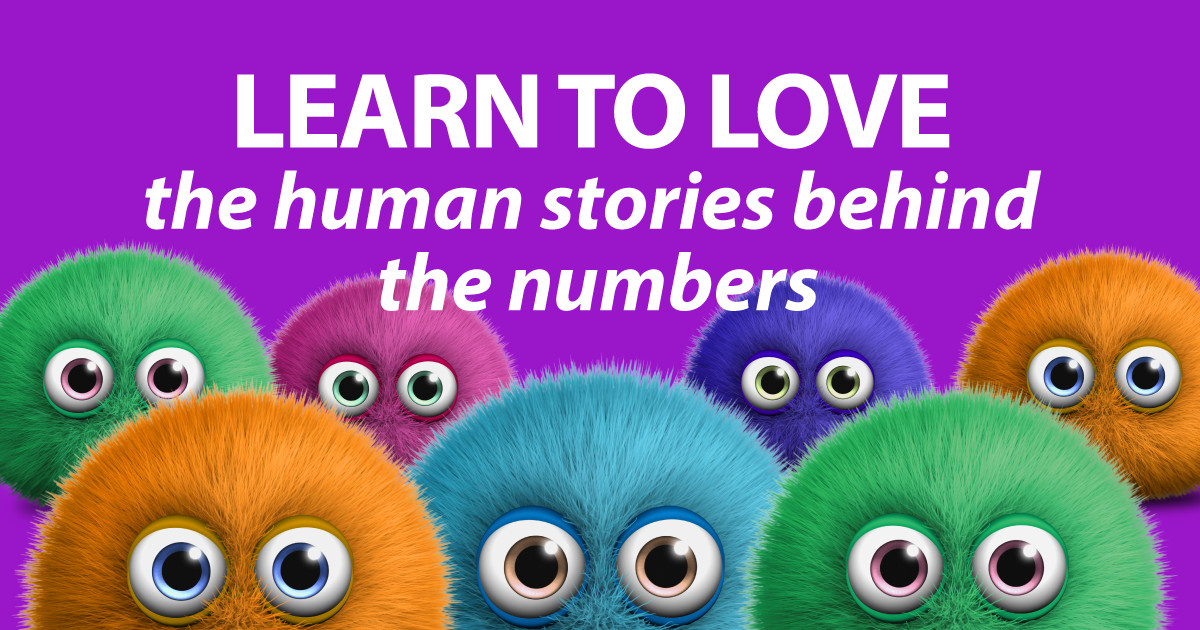
CU Numbers Need Marketing Love, Too
Quick, what’s your CU’s current Net Worth/Total Assets ratio? How about Total Loans/Total Shares? What percentage of your members are borrowers? How do these compare to other CUs like yours? Where do you even find these numbers?
Now go deeper… WHY are these numbers what they are? Where does your CEO want them to go?
What’s the story you want the numbers to tell, and what’s the story they actually tell?
Here’s why CU marketers, even the “creative types”, need to learn to see and love the human stories buried in the raw numbers.
Your tax dollars at work
First, what numbers are we talking about? Start with the public information reported by all Federally insured credit unions to the NCUA quarterly. You can get Call Reports and FPRs (Financial Performance Reports), free of charge straight from the NCUA’s website.
There’s a ton of great data in the Call Report, of course, but let’s start with an FPR, which calculates and summarizes a lot of key ratios and has “Peer Average” data for context.
- Use the Research a Credit Union tool on NCUA’s website: https://mapping.ncua.gov/ResearchCreditUnion
- Make note of the Charter Number, then click “Request FPR” (you can also get Call Reports or Profiles here if you want to explore further.)
- Choose “I want to view a 2-page FPR summary for one credit union online.” and click “OK”.
- Enter the charter number and click “Key Ratios”. Finally! (If you don’t see any results, or the “Peer Average” column is N/A, go back and change to an earlier Report Cycle.)
- Do the same for the other two FPR options to see even more data and dollar amounts.
Now, let’s look at a couple of simple indicators. For example, the Net Worth ratio at the top — is this significantly higher or lower than peers? Why might that be? Where does your Board and CEO want to see this number, and why?
Further down, look for the net growth numbers over the past several quarters. Are you seeing too much deposit growth and too little loan growth? Is growth in balance or flatlining? What happened in your town to make the numbers move in the third quarter of 2022?
Keep rummaging through the reports, and do a little calculating. Look for things like assets per member, salary & benefits per employee, and delinquency ratios. Are these higher or lower than average, and what stories do they tell about things like product and pricing decisions, the local market, and your members’ financial health?
Learn to paint by the numbers
ALM isn’t the ALM committee’s problem; it’s your problem because you need to understand how marketing and branding moves the numbers, and why.
As a marketer, you know that emotions drive behaviors, and behaviors (like saving for a vacation, or buying a new car) drive the numbers. And in turn, the numbers drive the credit union’s behavior (products, policies, decisions) which affect the member’s emotions. It’s a big circle of human emotions and behaviors, communicated through numbers that are anything but dry when you know how to see them.
While it may take a lot of practice and imagination to understand the human stories behind the numbers, it’s well worth it. How else will you be able to tell if the numbers are telling the same story as your brand? Are you putting your money where your brand is?
Numbers, the love language of the C-Suite
You don’t need me to tell you that numbers make the world go ‘round. And of course that’s doubly true in any Board Room or C-Suite, especially at a financial institution.
This may be obvious, but knowing how to speak “CEO-ese” and “CFO-ish” are going to be good for your career. And not just out of vanity; these skills will make you a more effective marketer who can prove that marketing investments are great investments.
Heart points the way, numbers deliver
Of course, it’s important to point out that management “strictly by the numbers” is not what we’re talking about here. Credit unions are mission-driven, and genuinely connected to their members in ways that profit-driven businesses can’t be.
The CU’s purpose and mission are in the driver’s seat, but the numbers and the human stories behind the numbers are the engine and fuel that makes the whole thing go.
Gotta whole lotta love…
- New CU tech needs Marketing love, too
- Why love needs CU marketing love, too
- Compliance needs marketing love, too
- HR needs marketing and brand love, too
- CU mergers need marketing love, too.
- Fees need CU marketing love, too
- Indirect auto loans need marketing love, too.
- CUSOs need marketing love, too.
- Core Conversions need marketing love, too.
- CU Numbers Need Marketing Love, Too - April 2, 2024
- Will it blend? The only CU fintech question that matters. - February 13, 2024
- Solving the CU marketing “now what?” problem - January 16, 2024
